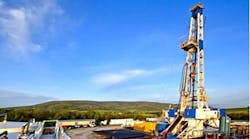The oilfield service companies that supply everything from sand to sophisticated robot rigs are seeking a new lease on life as America’s fracking fortunes begin to turn.
Shale drillers have added 158 rigs since May, according to Baker Hughes Inc. At the same time, companies such as Chesapeake Energy Corp. and EOG Resources Inc. have been increasing their efficiency by cramming more and more sand into individual wells, aiming to extend their reach miles further. That’s boosted sand prices roughly 25% to about $24 a ton, according to IHS Inc.
It’s an early sign that oilfield services, hard hit by a two-year slump in crude prices, are seeing the first hints of a turnaround. With spending by drillers in the lower 48 states now forecast to be $1 billion higher than analysts expected in the final three months of 2016, pricing talks are heating up as servicers face off against explorers fearful of uncertain oil prices ahead.
“Sand certainly led the way here, and that’s starting to make its way into other product lines,” James West, an Evercore ISI analyst. “It’s going to be a much more rigorous pricing recovery as we go into 2017, given the very ambitious drilling programs and production forecasts from the North American E&P industry.”
Oil-services companies sell explorers everything from the sand, water and chemicals they pump into the ground to the diesel that powers their equipment. Their services can include mapping pockets of underground oil, cementing wells in place and even breathing new life into old reservoirs.
Reopening Conversations
With West Texas Intermediate crude prices now up by about 80% from this year’s low, the industry is starting to use higher sand prices and the added activity in oil fields ranging from Texas’s Permian Basin to the Scoop and Stack plays of Oklahoma as an excuse to reopen conversations over how much they’ll be paid, said Samir Nangia, an IHS analyst.
Already, leases for more-efficient rigs that can walk from well to well and drill out several miles sideways, are up by as much as $5,000 a day, a third more expensive since May, according to Evercore.
Spending to drill and complete wells in the lower 48 states will be $13 billion, or about $1 billion more than previously forecast, for the final three months of the year, Jud Bailey, an analyst at Wells Fargo & Co., wrote in a Nov. 11 note to investors. He expects the strong year-end activity to carry over into next year.
Already robust demand for proppant is expected to expand over the next two years, analysts at Tudor Pickering Holt & Co. wrote on Nov. 28 in a note to investors.
Oil and natural gas wells in the U.S. are now expected to swallow 120 million tons of sand in 2018, up from a previous forecast of 95 million, according to the note.
IHS’s Nangia said service companies may boost prices by almost 10% a year through 2021. "We’re about 30% below full-cycle pricing, maybe even 10% below cash costs for a lot of the pumpers," he said.
For months, the service companies have been saying that the prices they’re able to charge aren’t sustainable. It’s a claim that’s been largely supported as more than 100 contractors in North America have gone bankrupt over the past two years, according to the law firm Haynes & Boone LLP.
While stock indexes for both explorers and servicers remain down by almost half since the downturn began in mid-2014, explorers are recovering more quickly. Both groups touched bottom on Jan. 20. Since then, oil explorers in the Standard & Poor’s 500 Index are up 59%, compared with a 28% climb in the Philadelphia Oil Services Index.
Negotiations between the sides won’t be easy, according to recent statements by Jeff Miller, president of Halliburton Co., the world’s largest fracking service provider, and Bob Dudley, the chief executive officer of BP Plc.
In a conference call with analysts and investors last month, Miller referred to pricing talks with explorers as "a brawl." Around the same time, Dudley said at the Oil & Money conference in London that he wants 75% of the cost reductions producers won during the market downturn to "stick," even if crude prices continue to rise.
The talks are occurring as oilfield contractors are increasingly teaming up with equipment makers in an effort to cut their own costs and offer oil explorers more streamlined and comprehensive options for the services and gear needed to siphon crude out of the ground. Schlumberger Ltd., for instance, bought manufacturer Cameron International Corp. this year. That was followed by an announced tie-up between Baker Hughes and General Electric Co.’s oilfield business.
Vienna Effect
Much of what happens from here will probably depend on what happens halfway around the world in Vienna. In September, OPEC said it would discuss an agreement to cut production to a range of 32.5 million to 33 million barrels a day. Since then, Iraq, Iran, Nigeria and Libya have sought exemptions. The 14-member group will meet in the Austrian capital on Nov. 30.
The oilfield price increases are “not a leap forward,” said Chase Mulvehill, an analyst at Wolfe Research. "This is a gradual shift upward in pricing, and that probably continues as we move into 2017, assuming that OPEC cooperates. If OPEC holds the line, or production continues to increase with OPEC, that puts a risk to the 2017 recovery story for U.S. onshore.”
Oil futures rose as much as 2.8% to $47.33 in intraday trading on the New York Mercantile Exchange. In order for onshore explorers to make more longer-term budget decisions, many would trade the higher, volatile oil prices for more consistency, according to IHS’s Nangia.
"Everybody feels that if we can be at $50 a barrel or higher, that would be helpful," Nangia said. "Stability helps."
By David Wethe



